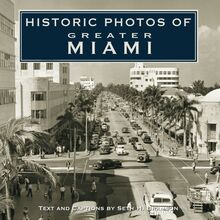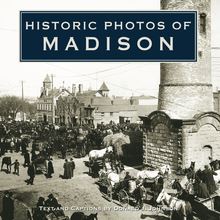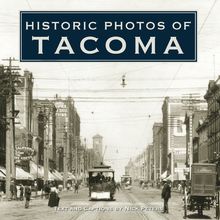Historic Photos of Knoxville , livre ebook
200
pages
English
Ebooks
2007
Vous pourrez modifier la taille du texte de cet ouvrage
Obtenez un accès à la bibliothèque pour le consulter en ligne En savoir plus
Découvre YouScribe en t'inscrivant gratuitement
Découvre YouScribe en t'inscrivant gratuitement
200
pages
English
Ebooks
2007
Vous pourrez modifier la taille du texte de cet ouvrage
Obtenez un accès à la bibliothèque pour le consulter en ligne En savoir plus
Publié par
Date de parution
01 mai 2007
Nombre de lectures
0
EAN13
9781618586469
Langue
English
Poids de l'ouvrage
43 Mo
Knoxville is an American city quintessentially founded upon change. From its birth to the present, Knoxville has consistently built and reshaped its appearance, ideals, and industry. Through changing fortunes, Knoxville has continued to grow and prosper by overcoming adversity and maintaining the strong, independent culture of its citizens.
Historic Photos of Knoxville captures this journey through still photography selected from the finest archives. From Knoxville as east Tennessee’s economic center in the nineteenth century to the revitalization of its urban center, Historic Photos of Knoxville follows life, government, education, and events throughout the city’s history.
This volume captures unique and rare scenes through the lens of hundreds of historic photographs. Published in striking black and white, these images communicate historic events and everyday life of two centuries of people building a unique and prosperous city.
Publié par
Date de parution
01 mai 2007
Nombre de lectures
0
EAN13
9781618586469
Langue
English
Poids de l'ouvrage
43 Mo
HISTORIC PHOTOS OF
KNOXVILLE
T EXT AND C APTIONS BY W ILLIAM E. H ARDY
This wintry scene of the Gay Street Bridge and Knoxville taken from the south shore of the Tennessee River captures an unusual sight: one of the rare moments in the city s history when the river was frozen solid (ca. 1910s).
HISTORIC PHOTOS OF
KNOXVILLE
Turner Publishing Company
200 4th Avenue North Suite 950
Nashville, Tennessee 37219
(615) 255-2665
412 Broadway P.O. Box 3101
Paducah, Kentucky 42002-3101
(270) 443-0121
www.turnerpublishing.com
Historic Photos of Knoxville
Copyright 2007 Turner Publishing Company
All rights reserved.
This book or any part thereof may not be reproduced or transmitted in any form or by any means, electronic or mechanical, including photocopying, recording, or by any information storage and retrieval system, without permission in writing from the publisher.
Library of Congress Control Number: 2007925966
ISBN-13: 978-1-59652-341-8
Printed in the United States of America
07 08 09 10 11 12 13 14-0 9 8 7 6 5 4 3 2
C ONTENTS
A CKNOWLEDGMENTS
P REFACE
F ROM THE C IVIL W AR TO THE C ENTENNIAL (1859-1899)
T HE T URN OF THE C ENTURY AND B EYOND (1900-1919)
A C ITY B ETWEEN W ORLD W ARS (1920-1939)
F ROM THE F ORTIES TO R ECENT T IMES (1940-1982)
N OTES ON THE P HOTOGRAPHS
A coal conveyor in one of the Myers-Whaley mines loads coal into a cart. Knoxville, strategically located in the center of a coal-producing region, was the headquarters of several coal-mining companies at the turn of the century.
A CKNOWLEDGMENTS
This volume, Historic Photos of Knoxville , is the result of the cooperation and efforts of many individuals, organizations, and corporations. It is with great thanks that we acknowledge the valuable contribution of the following for their generous support:
Library of Congress
McClung Collection
Tennessee State Library
Thompson Collection
University of Tennessee Knoxville
We would also like to thank the following individuals for valuable contributions and assistance in making this work possible:
Nick Wyman, William B. Eigelsbach, Elizabeth Dunham (Special Collections, University of Tennessee, Knoxville)
P REFACE
Knoxville has thousands of historic photographs that reside in archives, both locally and nationally. This book began with the observation that, while those photographs are of great interest to many, they are not easily accessible. During a time when Knoxville is looking ahead and evaluating its future course, many people are asking, How do we treat the past? These decisions affect every aspect of the city-architecture, public spaces, commerce, infrastructure-and these, in turn, affect the way that people live their lives. This book seeks to provide easy access to a valuable, objective look into the history of Knoxville.
The power of photographs is that they are less subjective than words in their treatment of history. Although the photographer can make decisions regarding subject matter and how to capture and present it, photographs do not provide the breadth of interpretation that text does. For this reason, they offer an original, untainted perspective that allows the viewer to interpret and observe.
This project represents countless hours of review and research. The researchers and writer have reviewed thousands of photographs in numerous archives. We greatly appreciate the generous assistance of those listed in the acknowledgments of this work, without whom this project could not have been completed.
The goal in publishing this work is to provide broader access to this set of extraordinary photographs that seek to inspire, provide perspective, and evoke insight that might assist people who are responsible for determining Knoxville s future. In addition, the book seeks to preserve the past with adequate respect and reverence.
With the exception of touching up imperfections caused by the damage of time and cropping where necessary, no other changes have been made. The focus and clarity of many images is limited to the technology and the ability of the photographer at the time they were taken.
The work is divided into eras. Beginning with some of the earliest known photographs of Knoxville, the first section records photographs through the end of the nineteenth century. The second section spans the beginning of the twentieth century through World War I. Section 3 moves to the era between the wars. The last section covers the 1940s to recent times.
In each of these sections we have made an effort to capture various aspects of life through our selection of photographs. People, commerce, transportation, infrastructure, religious institutions, and educational institutions have been included to provide a broad perspective.
We encourage readers to reflect as they go walking in Knoxville, strolling through the city, its parks, and its neighborhoods. It is the publisher s hope that in utilizing this work, longtime residents will learn something new and that new residents will gain a perspective on where Knoxville has been, so that each can contribute to its future.
Todd Bottorff, Publisher
An 1859 view of Knoxville s skyline looking south from photographer Thomas H. Smiley s home near the present-day intersection of Locust Street and Cafego Place. Smiley s image represents one of the earliest known photographs of a burgeoning metropolis on the eve of the Civil War. The Knox County Courthouse cupola can be seen at top-right.
F ROM THE C IVIL W AR TO THE C ENTENNIAL
(1859-1899)
By the late 1850s, Knoxville was East Tennessee s political and economic center. The peaceful antebellum town situated on the north bank of the Tennessee River had experienced a slow but steady growth since James White first settled in the region in 1786. Knoxville remained a village outpost protected by United States troops well into the nineteenth century until the advent of the railroads infused new life into the area.
The railroads arrived during an agricultural boom in the surrounding countryside, which was enabling the town to become a commercial hub for the Appalachian South. Wholesale firms, the retail trade, and small-scale industry thrived in the years prior to the Civil War. The constant ebb and flow of outsiders-a recurring theme throughout Knoxville s history-significantly influenced the city s economy, politics, and society during this period. Despite the presence of established families with names such as White, McClung, and Ramsey, who controlled a majority of the town s wealth, census records indicate that Knoxville in 1860 largely comprised impoverished newcomers and immigrants.
The Civil War shook the peaceful antebellum town violently. While East Tennessee is generally portrayed as a Unionist stronghold, Knoxville was split down the center: 49 percent of the population supported secession and 51 percent opposed it. Knoxville remained an occupied city throughout the war for all but three days. The transition from Confederate to Union control came in September 1863. A Confederate attempt to recapture the town ended after Southern troops suffered a bloody repulse in an attack on Fort Sanders, November 29. The national conflict ignited divided loyalties among neighbors in Knoxville that led to a troubled peace in the aftermath of the war.
Although the Civil War temporarily reversed the transformation of Knoxville into a burgeoning center of commercial activity, the postwar era witnessed a return to prosperity as northern capitalists-most of whom had served in the region under the Union flag during the war-flooded into Knoxville to invest in numerous businesses. By the turn of the century, Knoxville had emerged from the destruction of the Civil War and the debilitating Million Dollar Fire of 1897 to become a bustling, thriving metropolis.
Union soldiers encamp on the grounds of the Tennessee Deaf and Dumb Asylum located on Asylum Street (present-day Summitt Hill) in 1864. Ground was broken in 1848 and the school opened in 1851. The school closed during the Civil War as Confederate and Union armies began using the building as a military hospital. The building served as a school until 1924 when it became City Hall.
The environs of Knoxville as viewed from the south bank of the Holston River during the Civil War. (An 1890 federal statute recognized the junction of the French Broad and Holston rivers, to the east of Knoxville, as the root of the Tennessee River.) Union encampments at Fort Stanley appear in the foreground, and the three buildings that constituted East Tennessee University can be observed atop Barbara Hill across the river (1864).
The Strawberry Plains Bridge across the Holston River was one of several bridges targeted in November 1861 by the bridge burners, a group of East Tennessee Unionists. However, a lone Confederate sentry was able to fend off thirteen Unionists sent to burn the bridge. The group lost their matches and nerves when the Rebel soldier fired, wounding two men. During the course of the Civil War, the bridge was destroyed and rebuilt four times (1864).
George N. Barnard, a photographer stationed with the chief engineer s office of the Military Division of the Mississippi, captured this view of Knoxville from Fort Stanley in the wake of the Battle of Fort Sanders. At far-left are forts Dickerson and Higley, with East Tennessee University in the distance to the far right (1864).
Colonel Orville Babcock, seated on a tree stump, and Captain Orlando Poe pose for a photograph inside Fort Sanders in 1864. The fort, a hastily built yet bastioned Union earthwork, located west of Knoxville, was the scene of an ill-conceived Confederate frontal assault that resulted in the massacre of troops that the Confederacy could not afford to lose. The Confederates failure to capture Knoxville guaranteed Union control over the city and the majority of East Tennessee.
Gay Street has always been Knoxville s principal thoroughfare.














